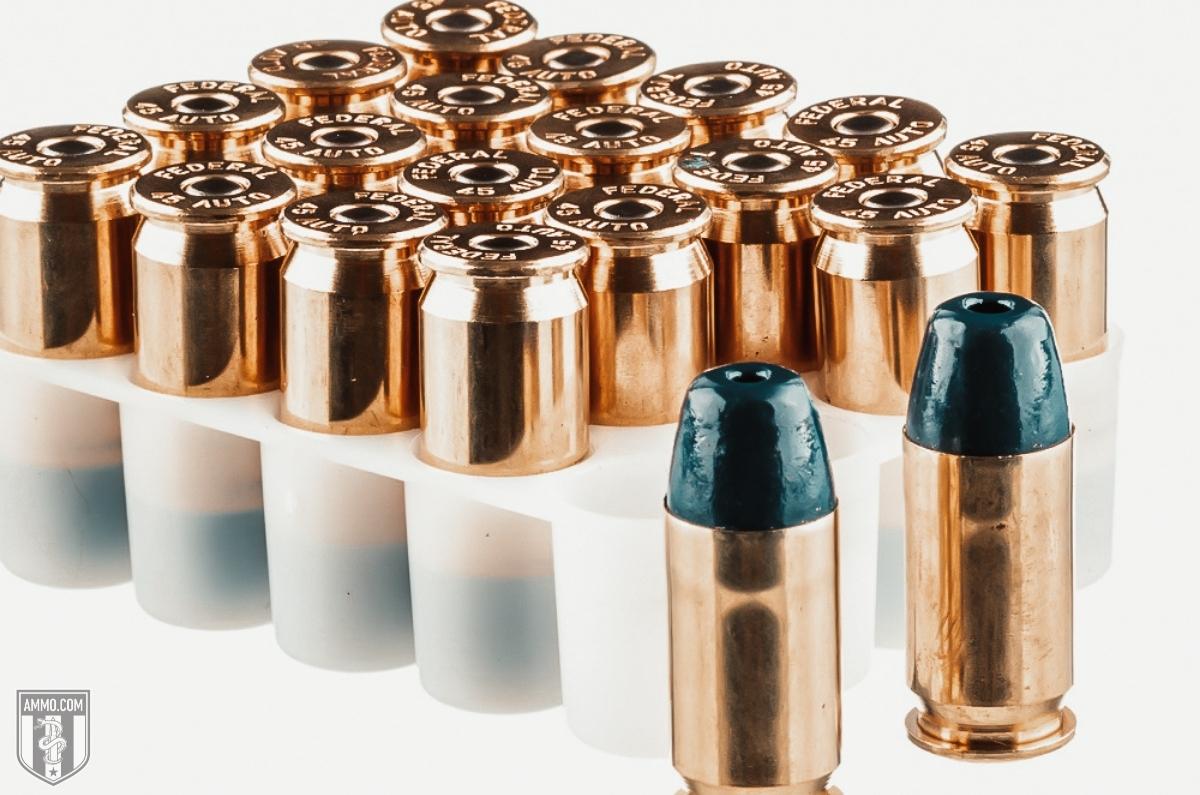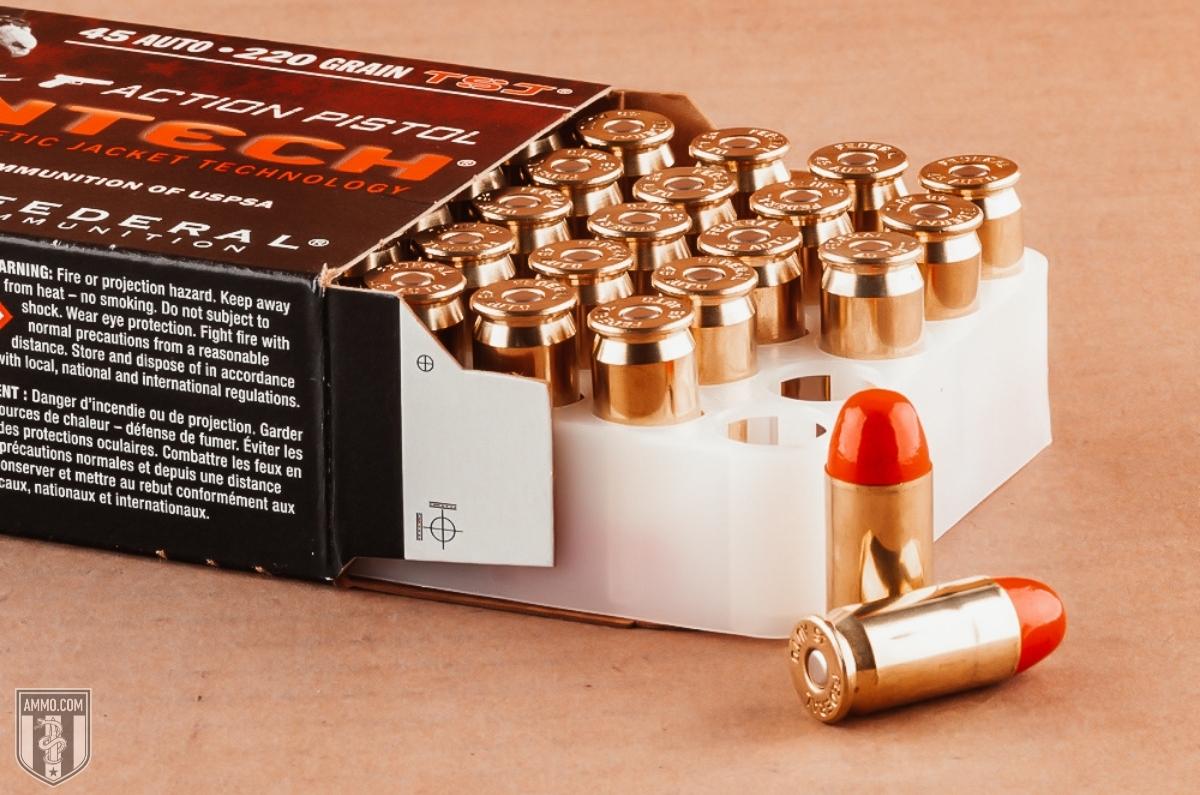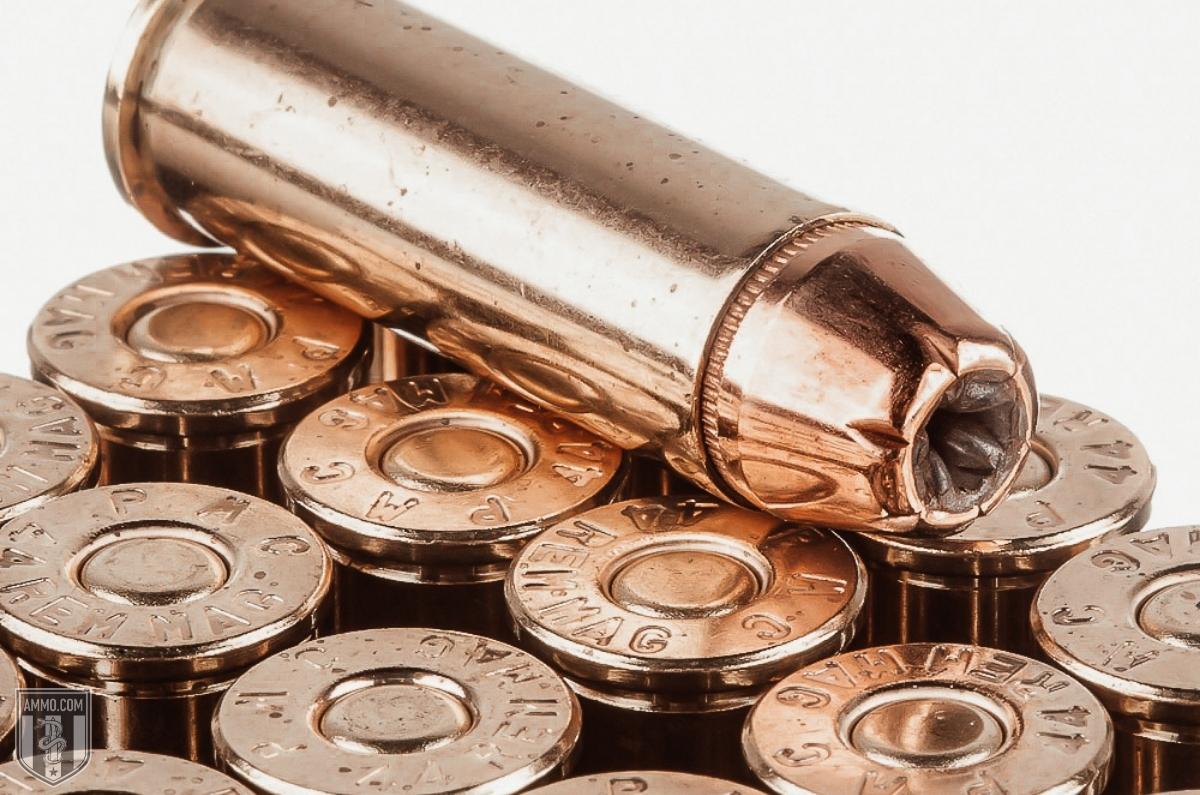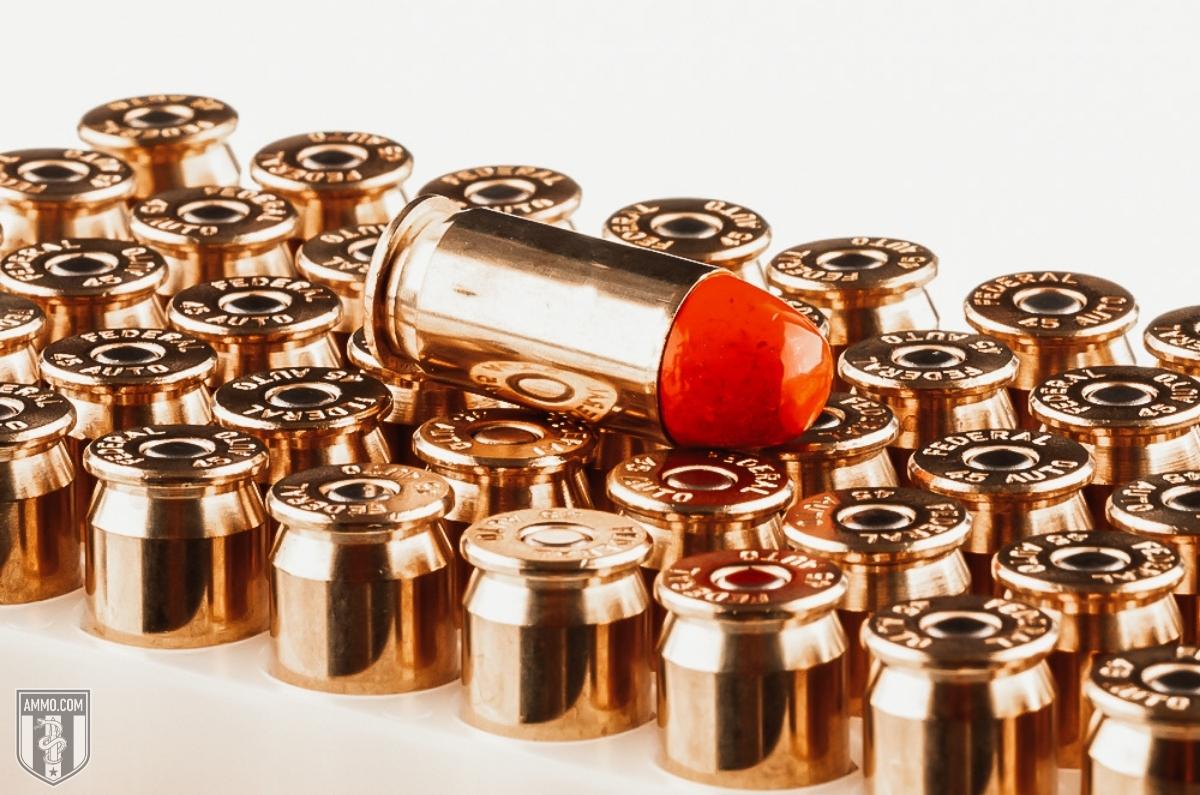44 vs 45: When Muzzle Energy Matters
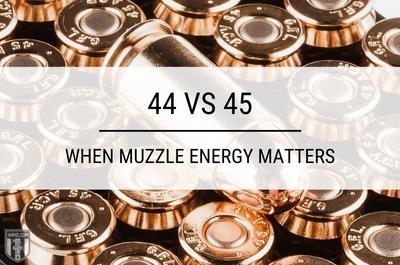 The 45 Automatic Colt Pistol (ACP) and 44 Magnum are two powerful handgun rounds that are rarely compared. Although the bullet that each cartridge fires is separated by only a few hundredths of an inch, the terminal ballistics of the 45 ACP and 44 Mag are considerably different from one another.
The 45 Automatic Colt Pistol (ACP) and 44 Magnum are two powerful handgun rounds that are rarely compared. Although the bullet that each cartridge fires is separated by only a few hundredths of an inch, the terminal ballistics of the 45 ACP and 44 Mag are considerably different from one another.
This leads some new (and experienced) shooters to question if they need a higher pressure 44 Magnum revolver for self-defense or if the 45 ACP has enough stopping power to do the job.
In this article, we will compare the 44 Magnum vs 45 ACP to help you understand the difference nuances between two of the handgun cartridges that are synonymous with home defense, firepower, and freedom.
What is The Difference Between 44 Magnum vs.45 ACP?
The primary difference between 44 Mag and 45 ACP is their cartridge case design. The 44 Remington Magnum was designed to be fired from revolvers or lever action rifles, while the 45 ACP was designed to be fired from a semi-automatic pistol. The 44 Magnum is by far the more powerful round, with almost double the foot-pounds of kinetic energy compared to the 45 ACP for many factory loads.
Cartridge Specs
When comparing two handgun rounds, it’s a good practice to examine the cartridge specs to gain a better understanding of each.
Perhaps the most striking difference between the 44 Mag and 45 ACP is how much larger the 44 is compared to the 45. The 44 Magnum has a case length of 1.285” and overall length of 1.61” compared to 0.898” and 1.275”, respectively, for the 45 ACP.
Although the 44 Magnum might be the taller of the two, the 45 ACP is wider with a 0.476” compared to 0.457” for the 44. The 45 ACP case needs to be wide because it fires a 0.452” diameter bullet compared to 0.429” for 44 Mag.
The 44 Magnum might be firing a slightly thinner bullet, but its case can hold 11.2 gr more propellant compared to the 45. The 44 cartridge has a case capacity of 37.9 gr compared to 26.7 gr for the 45 ACP. The added case capacity allows the 44 Magnum to fire heavier bullets at higher velocities compared to the 45.
However, all that case capacity comes at the price of pressure. SAAMI specifies that the 44 Mag can handle up to 36,000 psi while the 45 ACP can only withstand a maximum of 21,000 psi.
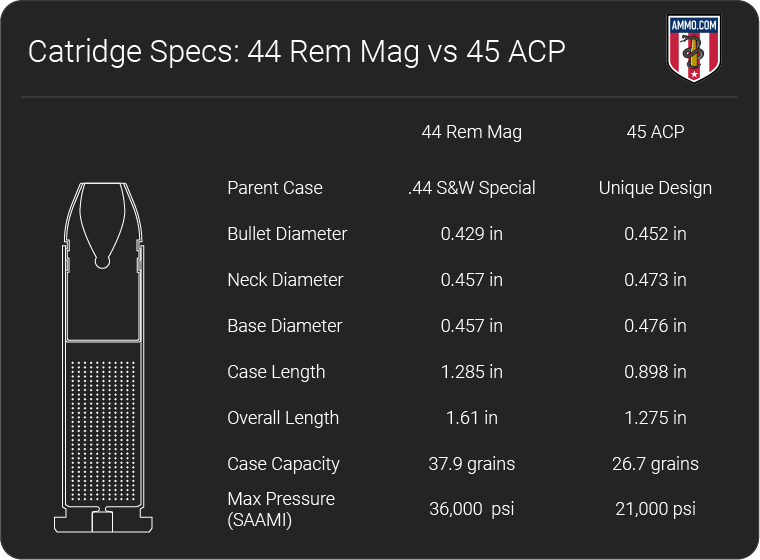
Stopping Power/Kinetic Energy
Stopping power is one of those ubiquitous terms that gets thrown around campfires and gun store counters and is completely unquantifiable. The important thing to remember is that shot placement is more important than any ballistic values as a .22LR between the eyes will always be more lethal than a 45 Long Colt to the hand.
However, we can quantify how many ft-lbs of force is imparted upon the target for each cartridge. And if there is one thing that the 44 Magnum is known for, it’s muzzle energy.
For this comparison, we will consider the Speer Gold Dot 185 gr jacketed hollow point (JHP) for 45 ACP and the Hornady 240 gr XTP JHP for 44 Magnum. Both rounds are popular with law enforcement and are excellent choices for self-defense. With these loads, the 45 ACP will have a muzzle energy of 453 ft-lbs compared to 971 ft-lbs for the 44 Mag.
That’s almost a 2x difference in favor of the 44 Magnum!
As the 44 Mag can be loaded to higher pressures and fire higher bullet weights, it will generally always have higher muzzle energy than the 45 ACP.
Recoil
Recoil is an important consideration when purchasing a new self-defense handgun. A round with heavy recoil (aka “muzzle flip”) will be more difficult to control and will negatively affect the rate of many shooter’s follow up shots.
Recoil is affected primarily by powder charge, muzzle velocity (FPS), bullet weight, and handgun weight. The faster a bullet travels, the harder it pushes back on the shooter. Furthermore, a heavier bullet requires more force to push it out the barrel, which is returned to the shooter’s wrists.
Although the 44 Magnum packs on the ft-lbs of kinetic energy, there is a price to be paid for all that power. That price is paid for in the currency of recoil.
One saving grace of the 44 Mag is typically a magnum revolver such as the single action Ruger Blackhawk are of a heavier design, and the extra steel weight helps soak up some of the recoil energy. Furthermore, most ammo manufacturers will intentionally load their 44 Magnum cartridges light to help curtail recoil. The truth is that full-power 44 Mag rounds are often not needed for self-defense, and the added muzzle velocity is not worth the resulting drastic increase in recoil.
To illustrate this, we will consider the two aforementioned self-defense loads for 44 Mag and 45 ACP, but also include the Buffalo Bore Heavy 44 Mag offering, firing a 305 gr lead flat-nose hard cast bullet.
The 185 gr Speer JHP for 45 ACP will have a free recoil of around 8 foot-pounds, while the 240 gr XTP for 44 Mag will clock in around 10 ft-lbs of free recoil. That’s not a huge difference and 10 ft-lbs of recoil is uncomfortable but manageable.
Now let’s consider the Buffalo Bore load traveling around 1,300 fps and 1,200 ft-lbs of muzzle energy. Given a standard Ruger Redhawk with a handgun weight of around 2.8 lbs, the Buffalo Bore load impart around 30 ft-lbs of free recoil pain into the shooter’s unsuspecting wrists. To put this into perspective, a 12 ga shotgun shell typically has a free recoil of around 27 ft-lbs.
This dramatic difference is a perfect example of how versatile the 44 Magnum cartridge can be. It can be loaded lighter for self-defense, or it can be loaded heavy for dangerous game such as brown bear.
In general, the 45 ACP will have lower recoil and allow for faster follow-up shots than the 44 Magnum.
Velocity/Penetration
The 44 Remington Magnum was made for speed and most factory loads will shoot faster and penetrate deeper than a 45 ACP.
Given the massive case capacity of the 44 Mag cartridge, it should come as no surprise that it will generally have a higher muzzle velocity when compared to the 45 ACP. Furthermore, except for +P loads, the 45 ACP will typically be fired at subsonic velocities.
For example, Winchester white box (WWB) 230 gr FMJ 45 ACP practice ammo will have a muzzle velocity of 835 FPS while a 240 gr WWB jacketed soft point will leave the barrel at 1,180 FPS.
Self-defense ammo will typically be loaded to higher velocities with commensurately higher pressures, but the trend will be similar, with the 44 Magnum having a higher muzzle velocity.
This is not to suggest that the 45 ACP has inferior penetration, on the contrary, it is an extremely potent handgun cartridge and was the round of choice for the U.S. military from WWI through Vietnam. However, the 44 Mag will generally have a higher muzzle velocity and therefore penetrate deeper than the 45 ACP.
Also take note that muzzle velocity is highly dependent on barrel length. A shorter barrel will typically result in lower muzzle velocity as the powder charge cannot be completely burned before the bullet exits the barrel. This is why handgun cartridge velocities are typically higher in a pistol-caliber carbine or lever action rifles as the barrels are longer.
Magazine Capacity
The 45 ACP is the clear winner when it comes to magazine capacity.
With a 44 Magnum revolver, shooters are mostly limited to a 5 or 6 round capacity. However, 45 ACP shooters enjoy the increased magazine capacity that a semi-automatic firearm offers. For example, the full-size Glock 21 has a 13-round capacity and even the timeless 1911 can carry 7-8 rounds depending on the magazine manufacturer.
The increase magazine capacity and speed of reloads were two of the major factors that drove the military and law enforcement to switch to semi-automatic handguns for service personnel.
Although speed loaders can increase a revolvers shooter’s reload speed, most 45 ACP semi-auto handguns will carry more than 6 rounds and have a greater magazine capacity than the 44 Magnum.
Hunting
The 44 Magnum makes an excellent big game hunting cartridge and has more than enough kinetic energy to ethically harvest whitetail with proper loads.
This is one of the reasons for the popularity of the 44 Magnum as it not only makes for an excellent home defense cartridge, but it doubles as an amazing hunting round as well.
There’s no denying that the 44 Mag produces a lot of recoil, but that recoil is considerably easier to handle when fired from lever action rifles like the Marlin Model 1894. Furthermore, it satisfies the straight-walled cartridge requirement of several Midwest states that prohibit the use of bottle-necked cartridges for deer hunting.
With its high muzzle energy and relatively flat trajectory for a handgun cartridge, the 44 Mag can easily claim a deer at ranges of 200 yards with standard hunting loads and elk within 100 yards.
The 44 Mag also makes an excellent choice for hogs or coyotes and, with proper loads, makes an excellent choice for bear protection. You’ll find many a 44 Magnum revolver on the hips of Alaskan hunting guides, as the round offers the power and penetration needed to punch through thick bear hide and bones to reach the vital organs.
The 44 Magnum was once the go-to handgun hunting cartridge of choice, as a Smith & Wesson Model 29 or Ruger Redhawk with a longer barrel length made for an incredibly accurate revolver. Although the 454 Casull has stolen some of the 44 Magnum’s handgun hunting market share, many hunters still prefer the classic look and feel of their beloved 44 Mag.
The 45 ACP is not generally considered a hunting round.
Although the 45 ACP offers faster follow-up shots and increased magazine capacity, these attributes are less important in a hunting environment when only one shot is needed in most cases.
Furthermore, the 45 ACP lacks the kinetic energy needed to ethically harvest a whitetail and lacks the flat trajectory preferred by varmint hunters.
For hunting, the 44 Magnum is clearly the better choice.
Concealed Carry/Home Defense
As the 45 ACP was designed for use in semi-automatic pistols, it is the better choice for concealed carry.
When carrying concealed, it is always preferred to carry more ammo than less. This gives a distinct advantage to the 45 ACP as its magazines carry more bullets and are easier to conceal than a revolver speed loader. Reload speed is also a consideration, as most shooters will be faster reloading a semi-auto compared to a revolver.
With concealed carry, weight is also a consideration. Most 45 ACP polymer-framed pistols will be lighter than a 44 Magnum revolver, this often translates to shooters being more likely to carry their 45 ACP handgun opposed to leaving it at home.
However, for home defense, handgun weight is less of an issue. This favors the 44 Magnum, as the added weight can actually be a benefit by decreasing felt recoil and muzzle flip.
However, there is one critical issue that needs to be discussed for any self-defense situation, and that is over penetration.
While over penetration is often less of an issue when hunting, as making a larger wound channel is preferred, it is a major consideration when shots must be taken indoors. There is little doubt the 44 Magnum is extremely powerful and will cause incredible amounts of damage to any would-be attacker, however the higher muzzle velocity and energy produced by the 44 Mag are a possible liability when fired inside the home or on the streets as it could potentially over penetrate and hit an innocent bystander. As you are legally responsible for every bullet you fire in self-defense, having a round that does not over penetrate is ideal.
Although any bullet has the potential to over penetrate, many shooters opt for the 45 ACP for both home defense and concealed carry as it is generally less likely to over penetrate for a variety of reasons already discussed in this article.
Modern jacketed hollow point ammo and reduced power loads will help alleviate the over penetration issue for many 44 Magnum loads. However, it is critical that you research your chosen self-defense round to determine if it will work for your revolver.
Ammo and Handgun Cost/Availability
When it comes to ammo cost and availability, the 45 ACP is clearly the superior choice.
The popularity of the 45 ACP has helped keep prices low and supply high, as shooters love the lower recoil and power that the round offers without punching holes in their wallet.
As far as variety is concerned, the 45 ACP holds approximately a 2:1 advantage over the 44 Magnum.
The 45 ACP is also less expensive, as FMJ practice ammo starts around $0.60/round and JHP defensive ammo goes for about $1.75/round and up. In contrast, the cheapest 44 Mag starts around $1.10 for practice ammo and will run you around $2/round or more for hunting and self-defense ammo.
Buying in bulk is always smart, make sure to check out our stock of bulk 45 ACP ammo.
The argument can be made that as the 44 Mag is relegated to primarily revolvers, most shooters will go through a box of 50 rounds slower than semi-auto 45 ACP shooters. That’s a fair argument, however most shooters would prefer to pay less per box of ammo in my experience.
As far as firearms are concerned, virtually every handgun manufacturer has an offering in 45 ACP. The 45 ACP is not only limited to semi-automatic handguns, as revolvers are also available in 45 ACP when used in conjunction with moon clips.
For the 44 Magnum, you are mostly limited to revolvers and lever action rifles. If you want a semi-auto 44 Mag, it can be had in the Desert Eagle platform. Sadly, the beloved Desert Eagle is cost-prohibitive for many gun owners. Ruger offers multiple revolvers in 44 Mag, such as the Ruger Blackhawk, Redhawk, and Vaquero (for the Cowboy Action shooters!) The Colt Anaconda and Smith & Wesson Model 29 are also classic revolver offerings in 44 Mag. In terms of rifles, Marlin, Rossi, and Henry have both lever action and single shot rifles available.
Just like with ammo, firearm cost is an issue for 44 Magnum. Many 44 Mag revolvers command upwards of $1,000 while a polymer-framed 45 ACP handgun can be had for $600 brand new. There are more budget-friendly 44 Mag revolvers like a Taurus but shooting a 44 Magnum is typically a more expensive proposition overall.
Reloading
One way that many shooters offset the high cost of ammunition is to reload their brass. Handloading allows shooters to customize their reloads to their particular firearm, allowing for the perfect amount of recoil with increased consistency and accuracy.
The 44 Magnum is particularly versatile when it comes to handloading. With a wide range of bullet weights available as well as the ability to fire jacketed to lead hard cast bullets, the 44 Mag lets handloaders make the perfect cartridge for their firearm.
With a multitude of bullets and powder available, it’s easy to make a reload that works perfectly for your shooting needs, whether that be inexpensive plinking ammo to high-powered hunting loads.
However, care needs to be taken when charging cases with powder. The massive case capacity of the 44 Mag makes it easier to accidentally double charge a case, meaning that double the amount of powder is put into the cartridge. This is particularly true when preparing reduced power loads, as the case is typically not close to being full.
A double-charged case can cause a critical failure as the round will be over pressured and could damage the firearm and/or shooter. Make a habit of visually inspecting your 44 Mag handloads before seating the bullet to ensure you don’t have a double-charged case.
The 45 ACP is the first cartridge many handloaders begin reloading. Bullets and powders are plentiful and easy to buy in bulk.
Double-charged cases are rarely an issue for 45 ACP. Most reloads fill the majority of the case with powder, and a double-charge would be easy to spot.
Both the 45 ACP and 44 Magnum are simple to reload and over a great amount of flexibility on how you want to customize your ammo.
Ballistics: 44 Magnum vs 45 ACP
Our team here at Ammo.com has spent countless hours scouring the Internet to bring you extremely comprehensive ballistics tables for both calibers. These tables will compare bullet weight to muzzle velocity, kinetic energy, and trajectory.
44 Magnum Ballistics
Note: This information comes from the manufacturer and is for informational purposes only. The actual ballistics obtained with your firearm can vary considerably from the advertised ballistics. Also, ballistics can vary from lot to lot with the same brand and type load.
| 44 Magnum Bullet WEIGHT | Muzzle VELOCITY (fps) | Muzzle ENERGY (ft. lbs.) | Mid-Range TRAJECTORY (in.) | Barrel Length (in.) | |||||
|---|---|---|---|---|---|---|---|---|---|
| Muzzle | 50 yds. | 100 yds. | Muzzle | 50 yds. | 100 yds. | 50 yds. | 100 yds. | ||
| 180 Grain | 1610 | 1365 | 1175 | 1035 | 745 | 550 | 0.5 | 2.3 | 4-V |
| 200 Grain | 1296 | 1193 | 1110 | 747 | 632 | 548 | -0.5 | -6.2 | 6" |
| 200 Grain | 1400 | 1192 | 1053 | 870 | 630 | 492 | 0.6 | n/a | 6.5" |
| 200 Grain | 1500 | 1332 | 1194 | 999 | 788 | 633 | n/a | n/a | 7.5" |
| 210 Grain | 1495 | 1310 | 1165 | 1040 | 805 | 635 | 0.6 | 2.5 | 6.5" |
| 225 Grain | 1410 | 1240 | 1111 | 993 | 768 | 617 | n/a | n/a | n/a |
| 240 Grain Medium Velocity | 1000 | 945 | 900 | 535 | 475 | 435 | 1.1 | 4.8 | 6.5" |
| 240 Grain Jacketed | 1180 | 1080 | 1010 | 740 | 625 | 545 | 0.9 | 3.7 | 4-V |
| 240 Grain Lead | 1350 | 1185 | 1070 | 970 | 750 | 610 | 0.7 | 3.1 | 4-V |
| 250 Grain | 1180 | 1100 | 1040 | 775 | 670 | 600 | 0.8 | 3.6 | 6.5-V |
| 250 Grain | 1250 | 1148 | 1070 | 867 | 732 | 635 | 0.8 | 3.3 | 6.5-V |
| 275 Grain | 1235 | 1142 | 1070 | 931 | 797 | 699 | 0.8 | 3.3 | 6.5" |
| 300 Grain | 1150 | 1083 | 1030 | 881 | 781 | 706 | n/a | n/a | 7.5" |
| 300 Grain | 1200 | 1100 | 1026 | 959 | 806 | 702 | n/a | n/a | 7.5" |
45 ACP Ballistics
Note: This information comes from the manufacturer and is for informational purposes only. The actual ballistics obtained with your firearm can vary considerably from the advertised ballistics. Also, ballistics can vary from lot to lot with the same brand and type load.
| 45 Auto (ACP) Bullet WEIGHT | Muzzle VELOCITY (fps) | Muzzle ENERGY (ft. lbs.) | Mid-Range TRAJECTORY (in.) | Barrel Length (in.) | |||||
|---|---|---|---|---|---|---|---|---|---|
| Muzzle | 50 yds. | 100 yds. | Muzzle | 50 yds. | 100 yds. | 50 yds. | 100 yds. | ||
| 150 Grain | 1050 | n/a | n/a | 403 | n/a | n/a | n/a | n/a | n/a |
| 165 Grain | 1030 | 930 | n/a | 385 | 315 | n/a | 1.2 | n/a | 5" |
| 165 Grain Guard Dog | 1140 | 1030 | 950 | 475 | 390 | 335 | n/a | n/a | 5" |
| 185 Grain | 1000 | 940 | 890 | 410 | 360 | 325 | 1.1 | 4.9 | 5" |
| 185 Grain Match | 770 | 705 | 650 | 245 | 204 | 175 | 2 | 8.7 | 5" |
| 200 Grain | 940 | 890 | 840 | 392 | 352 | 312 | 2 | 8.6 | 5" |
| 200 Grain | 975 | 917 | 860 | 421 | 372 | 328 | 1.4 | 5 | 5" |
| 230 Grain | 830 | 800 | 675 | 355 | 325 | 300 | 1.6 | 6.8 | 5" |
| 230 Grain | 880 | 846 | 816 | 396 | 366 | 340 | 1.5 | 6.1 | 5" |
| 165 Grain +P | 1250 | n/a | n/a | 573 | n/a | n/a | n/a | n/a | n/a |
| 185 Grain +P | 1140 | 1040 | 970 | 535 | 445 | 385 | 0.9 | 4 | 5" |
| 200 Grain +P | 1055 | 982 | 925 | 494 | 428 | 380 | n/a | n/a | 5" |
.44 Magnum Development/History
The 44 Remington Magnum, otherwise known as the .44 Magnum, 44 Mag, or 10.9x33mmR was developed in 1954 by the legendary American gun writer and handloader, Elmer Keith.
Keith began work on the 44 Magnum by using the 44 Special as a parent case. He selected the 44 Special over the 45 Long Colt due to the thicker walls of the 44 Special. As Keith wanted to make a round with higher pressure and higher velocity, the added case rigidity would help prevent critical failures in the brass. Furthermore, 44 Special cylinders would have thicker walls than a 45 Colt revolver, adding to the structural rigidity of the firearm and preventing cylinder failure from higher pressures.
The 44 Special case was elongated for the final design of the 44 Magnum and this change was made for two reasons. 1) It allowed for a higher case capacity, and 2) It prevented 44 Magnum rounds from being loaded into a 44 Special revolver. This was a similar concept used with the 38 Special and 357 Magnum.
Smith & Wesson announced the first revolver chambered in 44 Magnum in December of 1955 and released the revolver to the general public in January of 1956. This was the descendant of the Smith & Wesson Model 29, the gun made famous by Clint Eastwood’s character “Dirty” Harry Callahan in the movie Dirty Harry.
Although the terminal ballistics of the 44 Magnum are somewhat exaggerated in the movie as, “…the most powerful handgun in the world and would blow your head clean off…”, the 44 Mag provides law enforcement and civilian shooters with an extremely powerful handgun cartridge capable for both self-defense and hunting purposes.
Although the 44 Magnum has been eclipsed in power level by cartridges like the 454 Casull by Freedom Arms or the 500 S&W Magnum, the 44 Mag retains a huge following and is a cartridge that all other magnums are measured by.
Capable of taking down Cape Buffalo, elephants, and polar bears, the 44 Magnum has a hunting legacy that few other handgun cartridges can match. Capable of firing bullets as light as 200 grains all the way up to 340 grains, the 44 Mag offers gun owners a cartridge that is both excellent for home defense and big game hunting.
To learn more about the development and history of the 44 Magnum, check out our 44 Magnum history page.
45 ACP Development/History
The 45 ACP (Automatic Colt Pistol) was developed by the renowned American firearms inventor, John Moses Browning, in 1904. The 45 ACP was an innovation, as many are, birthed from necessity.
During the Philippine-American War, the US Cavalry became displeased with the lack of stopping power provided by their .38 Long Colt sidearms. The US military concluded that bigger bullets with more stopping power were required, and that the ideal caliber for this duty was .45 due, in part, to the success of the 45 Long Colt.
Prior to this development, John Browning had been working in tandem with Colt to develop a new 41 caliber for consideration. However, when this new order came from the US Military, Colt and Browning increased the caliber to .45.
Initially the new 45 ACP cartridge was designed to fire a 200-grain bullet at 900 fps. However, after some modifications by the Frankford Arsenal, Union Metallic Cartridge, and Winchester, the finalized version was adorned with a 230-grain full metal jacket (FMJ) fired at 850 fps.
The final version of the 45 ACP mimicked the ballistic performance of the 45 Schofield and the 45 Long Colt but was significantly shorter.
In 1906, Colt (using John Browning’s design) and 5 other firearms manufacturers submitted handguns for consideration. Only Colt and Savage Arms made the final cut in 1910.
The resulting testing run by the US Military showed the Colt submission experiencing zero failures while the Savage sidearm had 37 stoppages. The Colt handgun was selected as the Model 1911.
The Colt 1911 and the 45 ACP served in all branches of the US Military for the next 70+ years as the standard issue sidearm and ammo. It carried us through World War I and II, the Korean War, and Vietnam. It was not until the 1980s that the military decided to update their service pistol and opted to move towards the Beretta M9 and the 9mm Luger cartridge.
The 45 ACP is well known in the shooting community for its stopping power, accuracy, and reliability.
In general, the 45 ACP is a low-pressure round with SAAMI specs citing a maximum pressure of 21,000 psi (considerably less than 35,000 psi for 9mm). It is naturally subsonic, which makes it ideal for use with a suppressor/silencer or submachineguns.
Your standard, off-the-shelf 230 grain full metal jacket (FMJ) Winchester ammo will have a muzzle velocity of 835 fps and muzzle energy of 356 foot-pounds of force.
The 45 ACP is truly America’s Cartridge, and it has a huge following both in military, law enforcement, and civilian shooting circles across the USA.
To learn more about the development and history of the 45 ACP, check out our 45 ACP history page.
If you’d like to learn more about how the 45 ACP compares to other calibers, check out these articles below:
Final Shots: 44 Magnum vs 45 ACP
The 45 ACP and 44 Remington Magnum are two excellent handgun cartridge choices for self-defense. They both fire heavy bullets that have been proven as combat-effective from the battlefields of Europe, the South Pacific, and the concrete jungle as well.
The 45 ACP cut its teeth in World War I and served until the 1980’s as the handgun cartridge of the U.S. military. It has a huge following in law enforcement as well with civilian shooters, proving time and time again that the stalwart 45 ACP is more than capable to defend your life if the time should arise.
The 44 Magnum is an extremely powerful handgun cartridge that has a legacy of unparalleled stopping power. It is the magnum cartridge that all other magnums are measured by in terms of both muzzle velocity and kinetic energy.
The only downside to the 44 Mag is its punishing recoil, as full-power 44 Magnum cartridges can command as much recoil as a 12-gauge shotgun. This can be difficult for new shooters to handle and incredibly uncomfortable to shoot without proper training.
Although the terminal ballistics of the 44 Magnum are impressive, most shooters do not need that level of performance from their home defense handgun and will opt for the easier to handle and less expensive 45 ACP.
Deciding which cartridge is right for you depends on what your plan for using the round is.
If you plan on hunting and want to have caliber commonality with your carry gun, then the 44 Magnum is an excellent choice as the 44 Mag has the versatility to do both.
However, if you are just looking for a self-defense handgun that is powerful, fun, and less expensive to shoot, then you can’t go wrong with the 45 ACP.
But the one intangible aspect of this caliber comparison that cannot be measured is what trips your trigger. If you love the concept of the 44 Magnum and all the power that it offers, the go get yourself one and love every wrist-thumping trigger squeeze that the 44 Mag has to offer.
Regardless of your choice, make sure that you stock up on ammo here at Ammo.com and get the training and practice you need to ensure you’re ready to defend your life or freedom when the moment comes!
Ammo Comparisons
- .308 vs 5.56
- 6.5 Creedmoor vs .308
- .300 Blackout vs .308
- .300 Win Mag vs .308
- .243 vs .308
- .308 vs .30-06
- 7mm-08 vs .308
- .270 vs .308
- 7.62x39 vs .308
- .223 vs .308
- .338 Lapua vs .308
- .380 ACP vs 9mm
- .223 vs 5.56
- .300 Blackout vs 5.56
- 9mm vs 45 ACP
- 9mm vs 40 S&W
- .357 SIG vs 9mm
- 10mm vs 9mm
- 9mm vs 9mm Luger
- .243 vs .270
- .300 Win Mag vs .30-06
- .270 vs .30-06
- .40 vs .45
- 38 Special vs 357
- 9mm vs 40 vs 45
- 5.56 vs 7.62x39
- 338 Lapua vs .30-06
- .30-30 vs .30-06
- 300 PRC vs 338 Lapua
- .30-06 vs 7mm
- 300 Win Mag vs 338 Lapua
- 300 PRC vs 300 Win Mag
- 300 WSM vs 300 Win Mag
- 338 Win Mag vs 338 Lapua
- 12 Gauge vs 20 Gauge
- 10mm vs 357 Mag
- .30-30 vs 7.62x39
- 224 Valkyrie vs 22-250
- 17 HMR vs 22 Mag
- 7.62x39 vs .300 Blackout
- 45 ACP vs 45 Auto
- 45-70 vs 30-30
- 300 Blackout vs 223
- 357 Magnum vs 9mm
- 350 Legend vs 300 Blackout
- 224 Valkyrie vs 223
- 45 ACP vs 38 Super
- 6.5 Grendel vs .308
- 17 HMR vs 22 LR
- 10 Gauge vs 12 Gauge
- 22-250 vs 223
- 45 Colt vs 45 ACP
- 350 Legend vs 30-30
- 5.7x28 vs 223
- 5.7 vs 9mm
- 5.56 vs 5.7
- 22 vs 9mm
- Buckshot vs Birdshot
- 450 Bushmaster vs 308
- 450 Bushmaster vs 223
- Buckshot vs Slug
- 6.5 Grendel vs 5.56 vs 223
- 6mm ARC vs 6.5 Grendel
- 44 vs 45
- 458 SOCOM vs 5.56
- 357 vs 44
- 32 ACP vs 380
- 300 Win Mag vs 338 Win Mag vs 338 Lapua Mag
- 450 Bushmaster vs 458 SOCOM vs 50 Beowulf
- 6mm Creedmoor vs 6.5 Creedmoor
- TMJ vs FMJ
- 44 Special Vs 44 Magnum
- 45 90 vs 45 70
- 6.8 Western vs 6.8 SPC
- 50 Beowulf vs 50 BMG
- 26 Nosler vs 6.5 PRC
- 28 Gauge vs 410
- 6.8 SPC vs 5.56
- 6.8 SPC vs 6.5 Grendel
- 6.8 Western vs 7mm Rem Mag vs .28 Nosler
- 6.8 Western vs 6.5 Creedmoor
- 22 Hornet vs 223
- 6.8 Western vs 6.5 PRC
- .410 vs 12 Gauge
- .410 vs 20 Gauge
- 22 LR vs 22 Mag
- 6mm ARC vs 243
- 7mm-08 vs 270
- 243 vs 6.5 Creedmoor
- Nickel vs Brass Casing
- 204 Ruger vs 223
- 50 Beowulf vs 5.56
- 260 Remington vs 6.5 Creedmoor
- 6mm Remington vs 243
- 28 Nosler vs 300 PRC
- 50 Beowulf vs 50 AE
- 22 Nosler vs 22-250
- 450 Marlin vs 45-70
- 300 Win Mag vs 300 Norma
- 458 SOCOM vs 300 Blackout
- 38-55 vs 45-70
- 22 Hornet vs 22 LR
- 300 Norma vs 338 Lapua
- 338 Lapua vs 50 BMG
- 28 Nosler vs 300 Win Mag
- 28 Nosler vs 6.5 Creedmoor
- 204 vs 22-250
- 458 SOCOM vs 45 70
- 44 40 vs 45 70
- 6.8 SPC vs 6.5 Creedmoor
- 450 Bushmaster vs 30-06
- 7mm Rem Mag vs 300 Win Mag
- 30 Carbine vs 223
- 25-06 vs 30-06
- 26 Nosler vs 28 Nosler
- 16ga vs 12ga
- 30 06 vs 7.62 x54R
- 9mm Makarov vs 9mm Luger
- 350 Legend vs 223
- 30 Carbine vs 5.56
- 6.5x55 vs 6.5 Creedmoor
- 6.5 Creedmoor vs 270 vs 25-06
- M193 vs M855
- 450 Bushmaster vs 458 SOCOM
- 6.5 Grendel vs 6.5 Creedmoor
- 350 Legend vs 5.56
- .277 Fury vs 6.8 SPC
- 277 Fury vs 300 Win Mag
- 10mm vs .45 ACP
- 277 Fury vs 223
- 6.8 SPC vs 300 Blackout
- 6.5 PRC vs 6.5 Creedmoor
- 277 Fury vs 308
- 277 Fury vs 6.5 Creedmoor
- 350 Legend vs 450 Bushmaster
- 277 Fury Vs 5.56 NATO
- 10mm vs 40S&W
- 32 ACP vs 9mm
- 32 Special vs 9mm
- 8.6 Blackout vs 300 Blackout
- 30 Super Carry vs. 9mm
- 5.56 vs 9mm
- .50 Action Express vs 9mm
- 7.62x25 vs. 9mm
- 10mm vs 44 Magnum
- 300 Blackout vs 300 Win Mag
- 6.5 Grendel vs 300 Blackout
- 460 Rowland vs 10mm
- 300 RUM vs 300 PRC
- 300 Norma vs 300 PRC
- 45 GAP vs 45 ACP
- 7mm PRC vs 300 Win Mag
- 300 PRC vs 6.5 Creedmoor
- 300 PRC vs 308
- 357 SIG vs 357 Mag
- 7.62x39 vs 7.62x51
- 243 Win vs 223 Rem
- 30 Nosler vs 300 PRC
- 6.5 Creedmoor vs. 30-06 Springfield
- 450 S&W vs. 44 Magnum
- 6.5 Creedmoor vs. 300 Win Mag
- 454 Cassull vs. 45-70 Govt
- 454 Cassull vs. 44 Mag
- 7.62x54r vs. 308 Winchester
- 22 ARC vs. 223 Rem
- Subsonic vs. Supersonic Ammo
